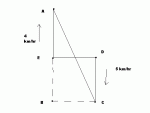Let's try it this way.
After the woman has walked 6 miutes, the man has walked 21 minutes. Therefore, he has walked (4)(21/60)=7/5 km
The woman has walked 5(6/60)=1/2 km.
From triangle ABC, The distance between them(AC) at 6 minutes after she starts walking is \(\displaystyle \sqrt{(19/10)^{2}+(2)^{2}}=\frac{\sqrt{761}}{10}\)km.
So, we can use ol' Pythagoras:
\(\displaystyle D^{2}=x^{2}+y^{2}\)
\(\displaystyle D\frac{dD}{dt}=x\frac{dx}{dt}+y\frac{dy}{dt}\)
They are moving apart vertically at dy/dt=4+5=9 km/hr. Since the distance between them stays at 2 km, then dx/dt=0.
\(\displaystyle D=\frac{\sqrt{761}}{10}, \;\ x=2, \;\ dx/dt=0, \;\ y=19/10, \;\ dy/dt=9\)
\(\displaystyle (\frac{\sqrt{761}}{10})\frac{dD}{dt}=2(0)+(\frac{19}{10})(9)\)
\(\displaystyle \frac{dD}{dt}=\frac{171}{\sqrt{761}}\approx{6.2} \;\ km/hr\)
I think this is a little easier since we do not have to deal with radicals in our differentiation.
For the previous method, \(\displaystyle \frac{dD}{dt}=\frac{1}{2}\cdot\frac{162t+18}{\sqrt{81t^{2}+18t+5}}\)
Now, if you plug in t=1/10, you should get the same result.

